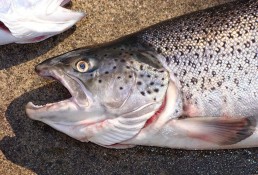Flies, Spinners or Live Bait: It’s all True Trout Fishing
SHARE THIS POST
Among the trout fishers, there is always a lot of discussion about what a “true” trout fisherman uses. On one hand, you have the purists, ones that will say that anything not caught on a fly is un-sportsman like. Some go so far as to proclaim that only dry flies should be used. These ones usually say that all trout should be released too. The others say that any artificial lure—the fly, a spinner, a fake minnow or other artificials—are okay, but that live bait is a definite no-no.
You also have fishermen that will use any of the above, plus live bait to catch their trout.
Who is right?
I will admit right up front that I fall into the third catagory. In my opinion, there is no right or wrong in these thoughts, but let’s look at some ideas about all of these options.
The fly “purist” is first. I fly fish quite a bit; there isn’t a more exciting part of trout fishing than to have a nice brookie come to the surface and take a dry fly. One of the most exciting evenings of fishing I ever had was when the mosquitoes were horrendous. I was battling them when I noticed that trout were rising all over the stream. I quickly tied on a mosquito dry fly and began casting it out. In 12 casts, I had 12 hits. I hooked 10 and landed eight; I released seven and then kept one. I have had other times when trout were hitting the dry flies. I am not a dry-fly purist and I use wets and streamers at certain times of the year and under certain water conditions. Letting a wet fly or streamer bump downstream can be deadly, especially early in the spring when the water is high. Trout tend to feed along the bottom, as there are still not too many insects for them to rise to. Fished correctly, this can be an excellent time to get action on the trout stream.
Are you enjoying this post?
You can be among the first to get the latest info on where to go, what to use and how to use it!
Now let’s take a look at the spinner and other artificial trout fisherman. Around the first month of the season, this is the method I’ll use. I use spinners and other small artificials where I wade and cat upstream with my fly rod. When I’m using these spinners and artificials I tend to fish and cast downstream. Although trout face upstream and you need to bring the lure past them, spinners give much better action when retrieved against the current. Also, with a spinner I feel that the vibration helps to alert the trout that food is coming through the water. I have success with this method in early spring. Later in the year, when the water has cleared up and is much lower, spinners are not nearly as effective. However, if in midsummer I come across a trout stream that looks good and I do not have my fly rod with me, I will still try some spinners. The reason I am able to do this is I always have a spin rod and a few spinners and lures in my car. When this happens, I am always ready. Now, with the water low, I simply wade downstream until I find a deep hole. I use Mepps, Panther Martin or Rooster Tail spinners or the small silver or gold Rapala. I usually carry these in my car with some larger lures for the occasional river or lake I come across.
Finally, let’s take a look at the live bait option. First, I would like to say to all of those who think it is too easy to catch trout using live bait—you are wrong. Knowing where and how to present live bait is important. While I always carry a half-dozen nightcrawlers, whether I am using my fly rod or my spinning rod, I seldom use any and I find less success with them.
Early in the spring when water is high and muddy, casting a crawler in a hole at and in an undercut bank will quite often get a trout. I caught my very first on a garden worm when I was 12 and I used to go to the stream on our farm and catch chubs and shiners for my uncle to take muskies fishing. The stream was a marginal trout stream and one day a stupid (he must have been) native brookie about 7 inches long took my worm. I did not really even know for sure what it was, but it was more fun to catch than the chubs and shiners. When I got home and found out it was in fact a trout, I became a lifelong trout fisherman. For the next three or four years, worms were the only bait I used for trout. I did not catch a lot of them, but I did learn a lot. The reason I continued using worms was because the only rod I had was a casting rod with a level wind reel. Finally, when I was 15, I did some work for my uncle and got a fly rod for payment. That was when I began fly fishing. It was even later before I began then using spinners. Back then, when I went out with my rod and worms, I could usually come home with a few trout.
The thing I am leading up to is to never look down your nose at another trout fisher because he does not use your favorite tackle or fish with your type of equipment. It takes just as much expertise to properly use live bait or spinners or flies. Each method has its own tricks and methods. For instance, I am probably best with spinners, next with flies and then worst with the live bait. However, I use all three methods and enjoy all three.
In my mind, there is no wrong way to fish for trout. The point is get out there and try for them. And if you catch some, keep some for a meal and put the rest back. I may be coming behind you and I would like some left for me to catch.
MWO
SHARE THIS POST
Did you enjoy this post?
You can be among the first to get the latest info on where to go, what to use and how to use it!



